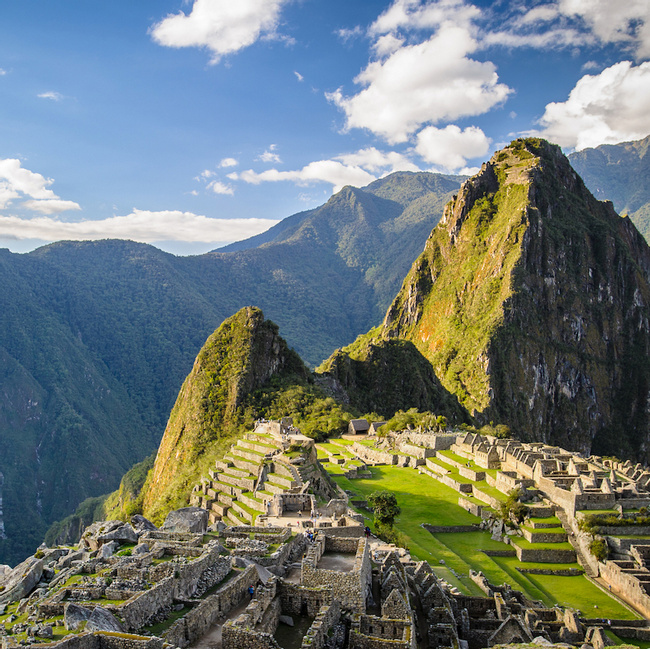- Travel Guides
Holidays and Festivals in Peru
Religious celebrations and holidays in Peru depend largely on geographic location. Many festivals are distinct to a region or city. In many regions, Peruvians mark Inca and Catholic holidays with equal fervor. Many Peruvians have both Spanish and indigenous ancestors, especially those living in Lima and the Arequipa region. It’s worth planning your trip around a large festival for the opportunity to see the history of the area expressed in dance, music, and crafts.

Keep in mind when planning your trip–one of the busiest holidays in Peru is the Fiestas Patrias. This holiday takes place from July 27th to 28th. Military parades take place all over Peru, with the largest of all happening in Lima. Many Peruvians take advantage of the federal holiday to go on vacation, so tourists in Peru must compete with locals for hotel reservations.
In cities across Peru, natives mark the week before Lent (the forty days leading up to Easter) with an explosive celebration. During February, on the days leading up to Lent, city streets overflow with the colorful ostentation of Carnaval parades, replete with lively water gun fights and ambushes. Easter week-Semana Santa-offers a huge variety of celebrations. Depending on the city or region, Peruvians celebrate with beautiful candlelit vigils, running of the bulls, and pageantry.
Like many other Latin American countries, Peru celebrates Día de los Muertos—the day of the dead. On November 2, revellers in ghoulish masks fill the streets. In some areas, locals mark the occasion by visiting cemeteries to decorate graves.
Lima and Arequipa
The 4th Sunday of every July is National Pisco Day, celebrated in towns and regions that boast a large production of pisco, such as Lima and Arequipa. Pisco is a grape-based brandy and the main ingredient in a pisco sour, the Peruvian national cocktail. This is a great time to schedule a visit to a local vineyard.
In October, the streets of Lima turn purple in honor of El Señor de los Milagros - the “Lord of Miracles.” During this festival, huge numbers of people gather to parade a 17th century image of Christ down the streets. According to locals, this image was one of the few items to survive an 18th century earthquake unscathed.
Cusco
In Cusco, Easter Monday marks the Fiesta del Señor de los Temblores, or, the Celebration of the Lord of Earthquakes. Celebrants parade an antique crucifixion through the streets, playing music and making offerings to the image. Locals believe that this particular depiction of Christ protects Cusco from earthquakes. The tradition started in 1650, when the crucifixion first arrived in the city from Spain during an earthquake. As soon as the statue arrived, the earthquake miraculously came to a halt. This festival echoes the ancient Incan tradition of parading the mummies of ancestors through the streets.
Dedicated to the Sun God, the ancient ritual of Inti Raymi is extremely popular among Cusco tourists. On June 24th, a procession moves from Qurikancha, the ruins of the Temple of the Sun, and moves to Sacsayhuamán, ruins located just outside of Cusco. Tourists attend during the winter solstice to get an eyeful of the masks designed by locals, and watch as an elected representative speaks to the Sun God. This festival was originally banned by the Spanish in the 16th century, and only recently experienced a revival.
Qoyllur Rit’i–the Snow Star festival–marks the beginning of the winter solstice, at the end of June. It takes place in the Sinakara Valley near Cusco. The Catholic version of this celebration marks a miraculous vision of Christ that appeared on the nearby Qullqipunku Mountain. Locals also use this festival to celebrate the Andean belief in the snow star that lives deep inside the mountain. Pilgrims climb the mountain at dawn to gather icicles, thought to have magical, curative properties. Tourists and pilgrims alike can attend the festival before the pilgrimage, although the pilgrimage is traditionally undertaken only by select believers. During the festival, attendees get to watch a procession and traditional dances, followed by a huge feast.
On December 24th, visitors to Cusco can get last-minute Christmas gifts at the Santuranticuy festival, the largest arts and crafts festival in Peru. Many of the handicrafts have a nativity or religious theme – Santuranticuy translates to “Saints for sale.”
It's more than just having a good time or visiting beautiful places (although that's absolutely a part of it!), it's about being part of a unique experience that stays with you.



